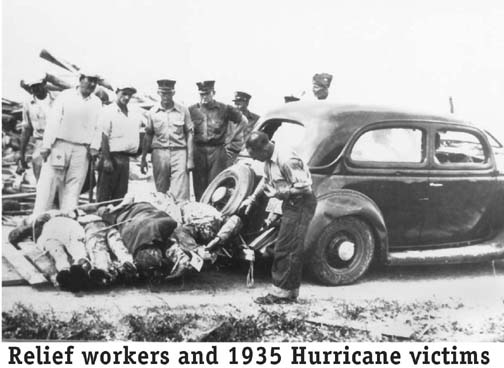Wet, deserted, silent.
The stench of death emanating from the heaps of scattered mangled bodies.
But whose fault was it?
On 2 September 1935, what is now known as the “Labor Day Hurricane” struck the Florida Keys, leaving over 400 people lifeless. Headlines such as “Hurricane Toll Is Mounting: War Veterans Among Victims” hit the newspapers instantly. The majority of the perished were, in fact, World War I veterans, sent there to work as part of their public duty. Five days after the storm, Ernest Hemingway was commissioned by the editor of the New Masses to write a piece that he then went on to call “Who Murdered the Vets?: A First-Hand Report On the Florida Hurricane”. In this, he gave what appears to be a personal account of the scene, which savagely reflected upon the inadequacy of the American government in dealing with the storm.
He begins his article with the bold question: “Whom did they annoy and to whom was their possible presence a political danger?”. With this, the tone is set. You know that someone must take the blame.
President Roosevelt’s government was, in fact, held accountable for the death of the veterans, not having evacuated them in time. As the vicious nature of the hurricane tore its way through the Keys, Hemingway likewise castigated the government’s actions with his words, exposing their ineptitude in dealing with the matter. However, were they truly the ones to blame? The Weather Bureau had not realised the true path of the storm until it was too late to evacuate. But isn’t nature unforeseeable? Surely, in 1935 they did not have the means by which to judge the extent of the hurricane with accuracy.
Validity aside, as an author, Hemingway is inspirational. His style is particular and original. It is capable of jolting the reader in and out of the text, provoking a public reaction. He immediately seizes your attention with his opening provocative questions. He pulls you into the story by the end of the first page, reaching out to “you” as a person. Just like that, you are involved. Fully immersed in something you would not usually think twice about. So tell me, do you think that veterans deserve peace and respect? …Hemingway definitely does.
First, you are there, at the Keys, you are taking precautionary measures before the storm hits. Next, you are outside of the scene looking in, hearing people speak but not knowing where they are. Hemingway’s use of unidentified dialogue produces an eerie atmosphere, jogging you in and out of complacency. His words enter your stream of consciousness, encouraging you to form an opinion on the situation.
His non-fictitious descriptiveness conveys the horror of the “bodies floating in the ferry slip”, and the men who were “face down, or faced up in the mangroves”. The use of words such as “tangled” are enough to paint vivid images in anyone’s mind, almost mimicking a photograph. Through these constant shifts in perspective, you are taken on a virtual tour of the scene, the purpose of which is to make you feel involved, angry and passionate about something that would usually be ignored, but that Hemingway chose to bring it to life.
Shouldn’t more of us be thinking like this?
Who really did "murder the vets"?
